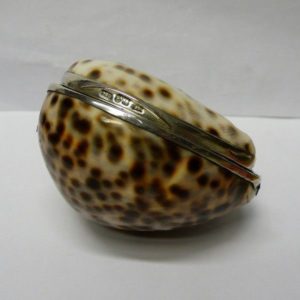Dougal Ged
Dougal Ged (worked from 1734), nephew of William Ged.
First mention of William Ged was in 1706. Born in Fife and apprenticed to Robert Inglis in 1696 William Ged became a Freeman in 1706. He is perhaps best known as the maker of a massive monteith, belonging to the Royal Company of Archers (the Queen’s Bodyguard for Scotland), inscribed 20th June 1720 and accompanied by a massive punch ladle. William was also the inventor of the ‘Stereo-typing’ printing process patented in 1725. William Ged died in poverty in 1749.
William’s nephew, Dougal, is more well known to collectors of silver. Jacksons’ first mentions Dougal in 1734. Born in Fife in 1701, Dougal was apprenticed to William Aytoun (b.1691-d.1754 and a former apprentice of William Ged) in 1718. He became a Freeman in 1734 and between 1738 and 1745 he was in partnership with his famous cousin, Ebenezer Oliphant, the maker of Bonnie Prince Charlie’s travelling canteen in 1740. Dougal Ged will go down in silver history because of a dispute between the Incorporation of Goldsmiths of the City of Edinburgh and the Assayer Archibald Ure in 1740, that lasted for four years until the impasse was halted by the appointment of Hugh Gordon as Assayer in 1744. While the dispute was ongoing, Dougal Ged and Edward Lothian were appointed Assayers on a ‘Pro Tem’ basis, and it is Dougal’s mark ‘GED’ in full that appears on silver assayed by him at Edinburgh at this period.
Dougal Ged
Dougal Ged (worked from 1734), nephew of William Ged.
First mention of William Ged was in 1706. Born in Fife and apprenticed to Robert Inglis in 1696 William Ged became a Freeman in 1706. He is perhaps best known as the maker of a massive monteith, belonging to the Royal Company of Archers (the Queen’s Bodyguard for Scotland), inscribed 20th June 1720 and accompanied by a massive punch ladle. William was also the inventor of the ‘Stereo-typing’ printing process patented in 1725. William Ged died in poverty in 1749.
William’s nephew, Dougal, is more well known to collectors of silver. Jacksons’ first mentions Dougal in 1734. Born in Fife in 1701, Dougal was apprenticed to William Aytoun (b.1691-d.1754 and a former apprentice of William Ged) in 1718. He became a Freeman in 1734 and between 1738 and 1745 he was in partnership with his famous cousin, Ebenezer Oliphant, the maker of Bonnie Prince Charlie’s travelling canteen in 1740. Dougal Ged will go down in silver history because of a dispute between the Incorporation of Goldsmiths of the City of Edinburgh and the Assayer Archibald Ure in 1740, that lasted for four years until the impasse was halted by the appointment of Hugh Gordon as Assayer in 1744. While the dispute was ongoing, Dougal Ged and Edward Lothian were appointed Assayers on a ‘Pro Tem’ basis, and it is Dougal’s mark ‘GED’ in full that appears on silver assayed by him at Edinburgh at this period.
-


Circa 1740
Dougal Ged
8461 Georgian Silver Cowrie Shell Snuff Box
Sold
A highly collectible antique sterling silver and shell snuff box with a hinged lid. Length 7.5 cms, width 6 cms, height 5 cms. The silver mount bears Scottish hallmarks (badly struck) for Dougal Ged, Edinburgh assay master. Circa 1740.